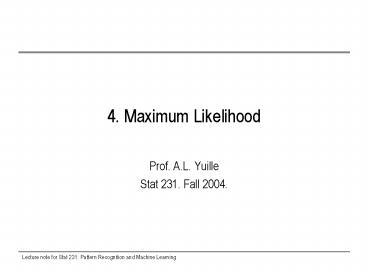4. Maximum Likelihood - PowerPoint PPT Presentation
1 / 11
Title:
4. Maximum Likelihood
Description:
Title: Slide 1 Author: Statistics Administrator Last modified by: aa Created Date: 1/3/2003 11:26:30 PM Document presentation format: On-screen Show – PowerPoint PPT presentation
Number of Views:94
Avg rating:3.0/5.0
Title: 4. Maximum Likelihood
1
4. Maximum Likelihood
- Prof. A.L. Yuille
- Stat 231. Fall 2004.
2
Learning Probability Distributions.
- Learn the likelihood functions and priors from
datasets. - Two Main Strategies. Parametric and
Non-Parametric. - This Lecture and the next will concentrate on
Parametric methods. - (This assumes a parametric form for the
distributions).
3
Maximum Likelihood Estimation.
- Assume distribution is of form
- Independent Identically Distributed (I.I.D.)
samples - Choose
4
Supervised versus Unsupervised Learning.
- Supervised Learning assumes that we known the
class label for each datapoint. - I.e. We are given pairs
- where is the datapoint and
is the class label. - Unsupervised Learning does not assume that the
class labels are specified. This is a harder
task. - But unsupervised methods can also be used for
supervised data if the goal is to determine
structure in the data (e.g. mixture of
Gaussians). - Stat 231 is almost entirely concerned with
supervised learning.
5
Example of MLE.
- One-Dimensional Gaussian Distribution
- Solve for
by differentiation
6
MLE
- The Gaussian is unusual because the parameters
of the distribution can be expressed as an
analytic expression of the data. - More usually, algorithms are required.
- Modeling problem for complicated patterns
shape of fish, natural language, etc. it
requires considerable work to find a suitable
parametric form for the probability
distributions.
7
MLE and Kullback-Leibler
- What happens if the data is not generated by the
model that we assume? - Suppose the true distribution is
and our models are of form - The Kullback-Leiber divergence is
- This is
- K-L is a measure of the difference between
8
MLE and Kullback-Leibler
- Samples
- Approximate
- By the empirical KL
- Minimizing the empirical KL is equivalent to MLE.
- We find the distribution of form
9
MLE example
We denote the log-likelihood as a function of q
q is computed by solving equations
For example, the Gaussian family gives close form
solution.
10
Learning with a Prior.
- We can put a prior on the parameter values
- We can estimate this recursively (if samples are
i.i.d) - Bayes Learning estimate a probability
distribution on
11
Recursive Bayes Learning































